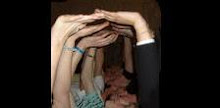 According to the Puranas, Brahma is self-born (without mother) in the lotus flower which grew from the navel of Vishnu at the beginning of the universe. This explains his name Nabhija (born from the navel). Another legend says that Brahmā was born in water. In this he deposited a seed that later became the golden egg. From this golden egg, Brahma the creator was born, as Hiranyagarbha. The remaining materials of this golden egg expanded into the Brahm-anda or Universe. Being born in water, Brahmā is also called Kanja (born in water). Brahmā is said also to be the son of the Supreme Being, Brahman and the female energy known as Prakrti or Maya.
According to the Puranas, Brahma is self-born (without mother) in the lotus flower which grew from the navel of Vishnu at the beginning of the universe. This explains his name Nabhija (born from the navel). Another legend says that Brahmā was born in water. In this he deposited a seed that later became the golden egg. From this golden egg, Brahma the creator was born, as Hiranyagarbha. The remaining materials of this golden egg expanded into the Brahm-anda or Universe. Being born in water, Brahmā is also called Kanja (born in water). Brahmā is said also to be the son of the Supreme Being, Brahman and the female energy known as Prakrti or Maya.Why is there no temple for Brahma ?
Once the creator Brahma and the preserver Vishnu were caught up in a war of words, each of them was of the view that he was superior to the other. Brahma felt that being the creator he had the more important brief and was thus more powerful to Vishnu. Vishnu on the other hand felt that being the preserver was a more difficult job and thus made him more powerful than the creator. Their battle of words soon turned into a full blown war and before long they were at each other’s neck fighting with a vigour and rage that only those blinded by their own arrogance and ego possess. Soon, all the other gods noticed this and knew that it will not be good for the world if this fight between the two gods continued any further. So (as always) they went to Shiva and sought his help in settling this dispute.
Shiva then assumed the form of a great pillar of fire (light linga) and appeared between the two fighting gods. Seeing this immense shaft of light stunned Brahma and Vishnu and they were quiet for a moment, wondering what such an unknown and mighty force might be. They then heard an asariri ( a disembodied voice) from the sky commanding them to listen. The voice then continued to say that the dispute of which of the two gods were superior to the other, would be settled if one of them was able to ‘see’ the top or the bottom of the pillar of light before them.
At once, it was decided that Brahma would go up (towards the sky) and try to find the head of this pillar of Light (Shiva) and Vishnu would go down (under the earth) to find the foot of Shiva. It was agreed that whoever was able to find the limit (the head or the foot) would be superior to the other. Brahma then assumed the form of a swan and began his journey into the sky. Vishnu on the other hand, assumed the form of Varaha (wild boar) and bored through the earth to descend into the very depths of the world. The two of them went thus on their quest for thousands of years and even still could find no end to the pillar of light (as light has no limit). After proceeding in their quest for so long, the two of them began to tire and realise that the supreme Shiva was indeed greater than either of them. This realisation began to humble their ego and their arrogance.
 Vishnu decided to end his search (becoming humbled) and proceed back to the earth. At the same time, Brahma saw a Ketaki (fragrant screw pine – Pandanus Sativa, kewra in hindi and thAzhampu in tamil) flower slowly wafting downwards from the sky. He stopped the flower on its way down and asked it where it was coming from. On being questioned by the creator, the flower replied that it had been placed at the top of the pillar of fire as an offering by a devotee and had fallen from there. Unable to find the head of the pillar, Brahma decided to end his search and instead use the ketaki flower as evidence of him having reached the head.
Vishnu decided to end his search (becoming humbled) and proceed back to the earth. At the same time, Brahma saw a Ketaki (fragrant screw pine – Pandanus Sativa, kewra in hindi and thAzhampu in tamil) flower slowly wafting downwards from the sky. He stopped the flower on its way down and asked it where it was coming from. On being questioned by the creator, the flower replied that it had been placed at the top of the pillar of fire as an offering by a devotee and had fallen from there. Unable to find the head of the pillar, Brahma decided to end his search and instead use the ketaki flower as evidence of him having reached the head.Both Brahma and Vishnu came back to the earth in the end and when asked, Vishnu replied truthfully that he had been unable to find the feet of the fiery pillar even after a very long search going to the very ends of the universe. Brahma on the other hand (to prove his superiority over Vishnu) lied by saying that he had in fact reached the head of the pillar of fire and that he had brought the ketaki flower from the top as proof of having reached there. This false claim angered Shiva and he revealed his true form and then cursed Brahma that he would have no temple dedicated to his worship as he was undeserving (as a result of his falsity) and he also cursed the ketaki flower that henceforth she shall not be used in the worship of Shiva (as she had given false testimony when questioned). Thus through his manifestation as a fiery pillar of endless light, Shiva quelled the arrogance of Brahma and Vishnu and revealed to them (and us) their place in the pecking order!
Some other books says that : When Brahma was creating the universe, He made a female deity known as Shatarupa (one with a hundred beautiful forms). Brahma became immediately infatuated with Her. Shatarupa moved in various directions to avoid the gaze of Brahmā. But wherever She went, Brahma developed a head. Thus, Brahma developed five heads, one on each side and one above the others. In order to control Brahma, Shiva cut off one of the heads. Also, Shiva felt that Shatarupa was Brahmā's daughter, having been created by Him. Therefore, Shiva determined, it was wrong for Brahmā to become obsessed with Her. He directed that there be no proper worship on earth for the "unholy" Brahmā.
According to another legend: Brahmā is not worshiped because of a curse by the great sage Brahmarishi Bhrigu. Once a great fire-sacrifice (yajna) was being organised on Earth with Bhrigu being the high priest. It was decided that the greatest among all Gods would be made the presiding deity. Bhrigu then set off to find the greatest among the Trimurti. When he went to Brahmā, he was so immersed in the music played by Saraswati that he could hardly hear Bhrigu's calls. The enraged Bhrigu then cursed Brahmā that no person on Earth would ever invoke him or worship him again.



1.there was a story told like this "dharma has two sons one is naarayana and another one is narudu(telugu)."what is this story is about ?.please explain it.
ReplyDelete2.who is narayana and vishnu?both are one or two different gods?